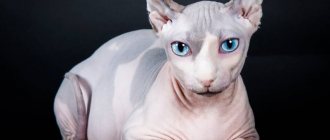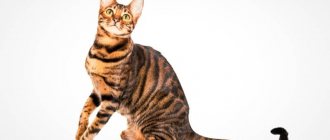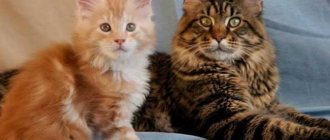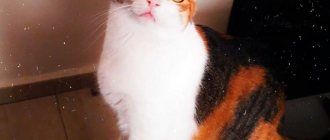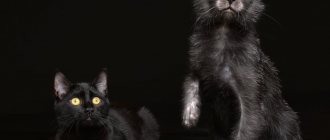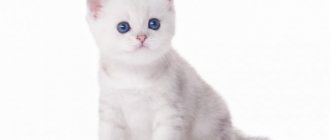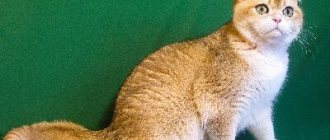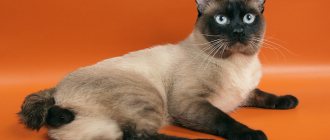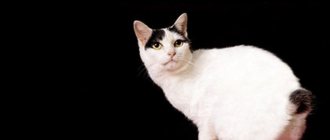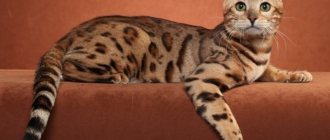Origin story
The Don Sphynx is one of the few cat breeds entirely of Russian origin. According to the generally accepted version, its story began in 1987. A teacher at one of the universities in Rostov-on-Don, Elena Kovaleva, returning home from work, took a cat away from children who were cruelly mocking her.
The woman kept the rescued pet and named it Varvara. After some time, the cat began to have serious problems - she began to rapidly go bald. Elena Kovaleva took her pet to veterinary clinics, where she had many tests done to identify lichen, dermodicosis, and other skin diseases - everything was to no avail. The cat was completely healthy, except for the fact that it had almost completely lost its fur.
White beauty
When Varvara gave birth to kittens from a cross with a European shorthair cat, they turned out to be hairless. The new owners of the babies considered them sick and destroyed almost the entire litter. Only one female was saved.
She was taken in by cat lover Irina Nemykina, fascinated by the “alien” mysterious creature. The woman became interested in breeding work aimed at consolidating the unusual physical characteristics of the baby.
She named the pet Chita because of its unusual paws for a cat, which more closely resembled monkey fingers. It is this cat that is recognized as the ancestor of the Don Sphynx breed.
The path to official recognition of the Donchak was long. At first, people refused to accept domestic sphinxes and considered them a mistake of nature. Then the breeder began giving cats to her friends. Having interacted closely with representatives of the breed, people began to recognize their uniqueness. The fashion for sphinxes grew, their small number and high price turned cats from “strange” into unique.
With the growth of popularity, the problem of a lack of quality individuals arose. Few kittens were born, many of them quickly died. Until the early 2000s, Don Sphynxes were crossed with representatives of other breeds to strengthen the gene pool. They mainly used European shorthair cats, but they also added the blood of indigenous varieties (for example, Siberian).
New Ragamuffin cat breed
The first breed standard was registered in 1992. Since 2000, the population has grown, interbreeding of sphinxes has been prohibited. Now they are used only by felinologists to breed new species. International recognition for the Donetsk team came in 1996, when they were recognized by the WCF.
Exhibition standards
Externally, the Don Sphinxes resemble ancient Egyptian figurines. These are cats with a slightly elongated, strong body with developed muscles and long limbs. The paws do not look fragile like those of other hairless cats, but are quite graceful.
Other breed standards:
- the head is embossed, wedge-shaped, of medium length;
- pointed muzzle with clearly defined cheekbones and brow ridges;
- forehead flat, narrowed;
- the neck is thin, not long;
- the nose is wide, in most cases darker than the rest of the muzzle;
- pronounced chin;
- the mustache is dense, thick, curling, in some individuals it breaks off right at the root;
- the ears are large, slightly rounded at the tips, set high and tilted forward;
- the toes on the paws are long, connected by webs;
- eyes of medium size, almond-shaped, slanted, without eyelashes;
- the iris is allowed in any color;
- the tail is thin, flexible, without creases.
The main feature of sphinxes is their skin. It is elastic and covered with folds. There are especially many “wrinkles” in the folds: on the forehead, neck, stomach, paws. Donchak dogs can be completely bald or have a specific coat.
Differences between the Don and Canadian Sphynx
Inexperienced owners may think that these breeds are almost the same, but this is not the case.
The Don and Canadian Sphynx have the following differences:
| Characteristics of the Sphinx | Donskoy | Canadian |
| Eye shape | Lemon-shaped. | Rounded. |
| Ears | Large, set wide, slightly inclined. | Larger than the Don one. |
| Head and muzzle | Wedge-shaped, with sharp, clear features. | Rounded contours. |
| Mustache | They are found, curled or broken. | They don't meet. |
| Neck | Graceful and muscular. | Powerful, wide. |
| Tail | Straight and long. | Thin, pointed tip. |
| Wool | Naked are possible. | Always pubescent. |
| Frame | Strong, large, wide chest. | Average body and chest sizes. |
| Possibility of metalization | Possible*. | Impossible. |
| Allele type | Dominant. | Recessive. |
* Crossbreeding of Don Sphynxes is possible with the following breeds:
- American Shorthair.
- Devon Rex.
- Domestic Shorthair.
- Home Sphinx.
According to the new decree, after 12/31/18, kittens must be purebred, without any admixture of other cats.
What are the varieties and their differences?
Depending on the length of the hair, experts distinguish four types of Don Sphynxes:
Darker colors
Naked
Unites completely hairless cats. They are considered the most exotic and valuable. They are not crossed with each other due to the high risk of giving birth to non-viable offspring. For knitting, folk or velor varieties are selected.
The skin type of these cats varies. In some cats it is dry and smooth, in others it feels like sticky rubber. At the same time, unlike Kohona, there are still small hairs on the body.
Folk
Flock
This type of breed can already be called hairless with a big stretch, since their body is covered with short, thin hair, similar to the fluff on a peach fruit. The densest fur is usually located on the tail and paws.
Usually, if there are no genetic abnormalities, by the age of two the hairs fall out and then the cat takes on the appearance of a hairless Don Sphynx.
Velours
Velours
A type of sphinx with hair reaching a length of 2-3 mm. It’s harder to call such cats beautiful. Outwardly, they look like ordinary yard cats that have suddenly gone bald.
In most cases, such pets also become completely bald with age, but sometimes the hair remains for life.
The velor variety still takes part in breeding.
Brush
Brush
Cats with hard, sparse, short, bristle-like hair. Brush Donchaks, unfortunately, do not take part in exhibitions, which does not prevent them from being excellent domestic cats.
At the same time, they are allowed for breeding. They are crossed with other Sphynx subspecies to improve the health of the breed.
There are even lovers of this particular variety who are not at all embarrassed by the pet’s lack of exhibition prospects
Description
The Don Sphynx is a medium-sized cat, muscular with a soft, wrinkled coat that is hot to the touch. The skin is very elastic, and wrinkles are located on the head, neck, belly, paws and tail.
The skin is similar in characteristics to human skin. A cat sweats when it's hot and can get sunburned or tanned. Since the cat sweats, it needs to be wiped daily and bathed quite often.
When autumn comes, the cat begins to accumulate fat, which disappears in the spring. They do not have a musky odor, and cats very rarely mark territory, if at all.
Like most cat breeds, male cats are larger than female cats and are distinguished in appearance by a thicker neck, broad chest and wider head.
Mature cats weigh 4-5 kg, and male cats weigh about 3 kg. Life expectancy depends on the conditions of detention, and is about 12 years.
There are four main types of hairlessness:
- hairless - completely devoid of hair, with hot and wrinkled skin, the most valuable of the breed
- flock - very short, almost invisible wool with a soft texture
- velor are short but noticeable hairs that disappear as the cat matures, up to two years of age. Partial hair may remain on the tail, paws, muzzle (usually the top of their head is bare from birth)
- brush - curly or wavy hair with bald spots (kittens lose much less hair over time than velor). It is considered a culling and is not allowed before competitions, however, it is widely used in breeding
By the way, the names flock and velor refer to the names of fabrics that resemble the fur of these cats. And a brush (English brush - brush, bristly) is a brush, they think no explanation is needed here.
Description of what it looks like and what colors there are
Any colors of the Don Sphynx are allowed, except lilac and chocolate. There are purebred Donchak dogs:
- white;
- black;
- gray;
- red;
- blue;
- red;
- pinkish.
Tabby-colored cats (patterned, striped) are also recognized by the felinological community, but they are classified into a separate subgroup, without division by pattern.
And here you will find the schedule of WCF cat shows for 2021.
Dimensions and parameters
Don Sphynxes are medium-sized breeds. Their height on average is 25-30 cm at the withers. The cats look much larger and more powerful than the thin, graceful cats.
The weight of a female sphinx is 3.5-5 kg; male – 5-7 kg. Owners should remember that neutered pets gain weight faster; they need to be careful to ensure that the cat does not overeat and moves more.
The body temperature of Don Sphynxes ranges from 38.0–39.5°C. Due to the fact that they have no hair, when you touch the skin, the cat seems to be hot.
Character of the breed
The Don Sphynx is affectionate, gentle, requiring care and communication. This is a completely non-aggressive animal, but touchy and vulnerable. The Sphynx Brush needs the owner's attention and loves to sit on a person's lap. He can be obsessive when petting him, but quickly realizes that the owner is busy and cannot pay attention to him.
By temperament, the Don Brush pet is sanguine. He is sociable, friendly, inquisitive, non-conflict. If he is not busy with an exciting activity or game, he dozes off in a cozy place.
The Don Sphynx is a wonderful partner for children's games. He willingly participates in children's undertakings, is patient with pampering, and will not allow himself to show aggression towards the child. The Sphinx's attitude towards other domestic animals is loyal and friendly. The pet is ready to share a home with large non-aggressive dogs, and with decorative rodents, and with birds.
Features of health, diseases, what causes people to die
The breed is quite young, so initial mistakes in breeding are still clearly affecting the health of the Don Sphynx.
These cats are genetically predisposed to pathologies such as:
- eczema;
- underdevelopment of the eyeball;
- skin vasculitis;
- congenital entropion of the eyelid;
- curvature of the caudal spine;
- nipple hyperplasia (in females);
- dermatitis;
- mammary cyst, most often found in tortoiseshell cats;
- conjunctivitis;
- shortening of the lower jaw. Donchak people with this anomaly are not able to eat properly and constantly damage the roof of their mouth with their teeth.
Donetsk people are protected from major infectious diseases by vaccination. The first vaccination is given to a kitten at two months of age; after 2-4 weeks, revaccination is carried out. At six months, a re-vaccination with a complex drug is prescribed, the procedure is repeated at 12 months, then the cat is vaccinated annually.
Donchaks must be protected from hypothermia (in winter they can catch a cold even in an apartment). In summer, pets' skin should be treated with sunscreen to prevent burns.
How long do they live?
On average, Don Sphynxes live 14-15 years. Castration (sterilization) increases the life expectancy of individuals of both sexes. If the owner does not plan to engage in breeding, veterinarians recommend this operation. However, keep in mind that you will have to change your diet in many ways after sterilization.
Thanks to it, the pet’s hormonal levels stabilize. In cats, the risk of developing prostatitis and testicular cancer disappears; in cats, diseases of the mammary glands and reproductive system disappear. Donchak people become friendlier and lose interest in running away from home. This is especially important for sphinxes. On the street, without human care, they can die in a few hours, since they are absolutely not adapted to a “free” life.
It is recommended to castrate cats at 7–8 months, after the testicles have completely descended into the scrotum. Cats are spayed at 4-5 months (before their first heat). This increases the lifespan.
How are they different from other breeds?
Non-specialists often confuse the Don Sphynx with the Canadian Sphynx. These are two completely different breeds, but how can you tell them apart? Let's make a comparison. Among the most striking external differences:
Comparison of three similar breeds
Canadian Sphynx
- the shape of the “Canadian’s” head is round, less prominent than Donchak’s wedge-shaped muzzle with pronounced cheekbones and chin;
- the body of the overseas sphinx is strong, muscular with a wide, rounded sternum;
- the limbs of the Canadian hairless cat are longer and more powerful;
- the “Canadian’s” eyes are round, with a green iris, while the “Donetsk” ones are almond-shaped, any color is acceptable;
- The ears are large and wide in both breeds; in the Canadian they do not have rounded tips.
For Canadian Sphynx cats, only one type of coat is acceptable - short, inconspicuous hair, which feels like suede to the touch. These kittens are not born naked; they lose hair as they grow older.
The main difference between the two breeds is that different genes are responsible for their “baldness.” Among “Canadians” it is recessive, that is, both parents must be born hairless kittens without fur.
The Don Sphynx is always a carrier of the dominant gene. Even from mating with a “hairy” cat, hairless individuals will be born. People often ask, is it possible to cross them?
Warning! Due to genetic differences, crossing the Canadian and Don Sphynx is strictly prohibited!
It's difficult to say who is better to choose. The undoubted advantages of donchak are a healthier heart and stronger immunity, which makes it less vulnerable to the harmful effects of viruses.
Peterbald
Another similar breed is the Peterbald (Petersburg Sphynx). She was bred during the process of improving the Don variety of hairless cats. As a result of breeding activities, elegant cats with light, elongated bones and thin long limbs appeared. The calling card of the breed is its huge, very wide ears at the base. They are set low and spread out to the sides. Breeding Peterbald with other breeds of Sphynx is also unacceptable.
Despite the differences in appearance, hairless cats have similar personalities. All of them, Elf, Minskin, Dwelf, Ukrainian Levkoy, and Bambino, are affectionate, friendly, and focused on communicating with people.
Description of cats of the Don Sphynx breed
Cats belonging to the Don Sphynx breed have an extremely unusual appearance, which really resembles the cat figurines of Ancient Egypt: flexible, elegant animals with long legs and very large lively eyes.
The very description of the appearance of the Don sphinxes recalls the mystery of their origin: they seem to be aliens from outer space. However, while characterizing the breed, it is nevertheless possible to highlight its distinctive features.
Don Sphynxes have a strong and muscular body. The fact that cats don't have hair helps us see their almost athletic physique better. The animal's croup is quite wide; it happens that its width exceeds the width of the shoulders, as a result of which the silhouette of the cat resembles a pear in shape.
The size of the Don Sphynx is standard, medium, similar to the size of many other cats.
The paws of these cats are long and graceful, they look surprisingly fragile, but in fact this is not the case at all. The front legs are shorter than the hind legs. The fingers are also long.
The Sphynx's tail is long and thin, with a rounded tip. In general, the cat’s entire body seems long and fragile, which makes its appearance even more mysterious.
Adult females weigh about five kilograms, and Don Sphynx cats weigh about seven kilograms.
The cat's head is wedge-shaped with pronounced cheekbones and brow ridges. The chin is small, but quite powerful, and the nose is medium-sized, smooth and straight.
On a flat forehead, fan-shaped skin folds are clearly visible, smoothing out under the eyes.
The ears of the Don Sphynx are quite large and wide with rounded tips and a slight slope. The eyes are oval shaped and small in size. Eye color is not limited by any standards. One of the outstanding features of cats of this breed is that kittens’ eyes open almost immediately after birth, just a few hours later. Don Sphynxes do not have eyelashes, nor mustaches; cats with curly mustaches are only very rarely found.
Based on existing standards, the cover of the Don sphinxes can be of three varieties. These cats are not always completely naked.
The following types of cover exist:
- bare-born - animals born without hair, their fur feels like rubber to the touch;
- velor (flock) – there are very short hairs, the skin feels like velor to the touch;
- brush - developed wool, but still rare. The peculiarity of cats with such fur is that they can get rid of it and then grow it back.
Newborn kittens may have fur that will disappear around age two.
The color of the Don Sphynx is varied:
- pure white;
- smoky;
- black;
- ginger;
- red-pink;
- blue;
- lilac.
Character
Behind the mysterious, aloof appearance of the “alien” hides the affectionate, vulnerable soul of the Don Sphinx. These cats require constant contact with the owner. They choose for themselves the main person in the house, urgently need his attention, and get bored during a long separation.
At the same time, Donchak dogs are not jealous, they calmly relate to the presence of other animals in the house. They are happy to make friends with cats and are loyal to small rodents and birds. They are very patient with children, they rarely lose their mental balance by using their claws.
Warning! Sphinxes do not tolerate loneliness very well. People who are constantly missing work should not have such cats.
The loving “Rostov resident” is always happy to sit on the owner’s lap and receive his share of affection, but will not impose himself at the wrong moment. These cats are subtle psychologists, acutely aware of the mood of family members. If the owners are not inclined to communicate with the pet, they prefer to wait until the situation normalizes.
The Sphynx kitten behaves like a little hurricane. She loves to run around the house, covering the entire space of the apartment with her games. It can attack people's legs, tear off furniture or wallpaper. To prevent this from happening, the baby must be provided with a sufficient number of toys and given as much attention as possible. Some dog toys will also work.
The character is quite balanced
If you can’t do a lot with the little robber, you should get a second cat of the same breed. Sphinxes get along well with each other and will happily spend time having fun together.
With age, most Donchak people settle down. They become moderately lazy. They spend time with equal pleasure both in active games and lying on the sofa next to their owners.
Representatives of this breed have developed intelligence, but will not do anything against their will. The proud aristocrat considers himself equal to man, so he will not bring slippers on command, but if desired, he will please the whole family with funny acrobatic tricks.
Thanks to the developed mind of the Sphynx, it is not difficult to accustom him to a scratching post or tray; if desired, you can even teach him to use the toilet. But because of the bald man’s intelligence, not a single closet in the apartment will remain inaccessible to him. Almost every adult Rostovite easily opens all the doors and pushes the bolts away with his flexible fingers.
From childhood, you need to accustom your baby to hygiene procedures. Representatives of this breed need to do them a lot and often. If you start manipulating as an adult, the cat will desperately resist, and every wash will turn into a mini-war. A Sphynx accustomed to procedures at an early age will take them calmly.
Character and behavior
Kittens are distinguished by rapid intellectual development. They are active and playful. Cats at that age are curious and explore every corner of the house. Babies require constant attention. Being alone for a long time, they get bored and cry.
Don Sphynx kittens
The character is finally formed by 8 months. Over time, the Donetsk people settle down. Cats that retain reproductive function are constantly looking for a partner. At the same time, they are independent, prefer to sleep in the sun on the windowsill and are not interested in games, remaining passive observers. At night, they become more active and can howl and purr, calling for a female. Cats fiercely defend their territory and mark it with urine. Males can be capricious, can dictate the feeding schedule, and often do not want to obey the owner. But at the same time they are affectionate, and towards all family members. After castration, cats retain their gracefulness and mobility.
Video - Don Sphynx demands affection from its owner
Females have a rather gentle character. But they are more active, playful, and need attention. At the same time, they are characterized by cunning and dexterity, and a tendency to change moods. In general, the behavior of Don Sphynx cats is dictated by the conditions of detention and the attitude of the owner towards them. Donchak people get along well with other fauna, be it rodents or birds. They even get along with dogs and try to avoid quarrels.
Differences in the behavior of a cat and a cat
All individuals are individual in character, but there are some characteristic differences between different sexes of the Don Chak. Cats are more independent, curious, and decide for themselves when they want to receive affection from their owners and when to be left alone. In addition, their secretion has a more pungent odor.
Hairless cats, as a rule, are more clean, affectionate, strive for close contact with their owners, and require increased attention. Unlike other animals, sphinxes are not always kind to their offspring, sometimes refusing to feed the kittens. The best parents are Brush Sphynxes.
Beautiful photo
Isn't he handsome?
A specimen with some fur
Ready to jump
We love to sleep comfortably
Happy mother with children
Care and maintenance rules
The absence of fur does not make everyday care of the Don Sphynx much easier. It does not need combing, but the skin needs to be constantly treated. Through the pores of cats, a specific sticky brownish substance with a specific odor is released. It accumulates in folds and serves as fertile ground for the proliferation of pathogenic bacteria.
Leather
Cats need to be bathed twice a week with shampoo for hairless animals. The water temperature for washing should be maintained at 39-40 °C. To prevent skin irritations, it is good to add infusions of string or chamomile to the bath. After the bath procedure, the cat should be placed in a warm room and thoroughly blotted with a soft towel.
In between washings, the secretion should be removed with damp gauze or alcohol-free wipes. The spine area (including the tail) is a problem area for Donetsk. Pimples, boils, and rashes often form here. To avoid their appearance, this area should be wiped with a special lotion, then rinsed with water so that the cat does not lick off the cosmetic product. There are many sebaceous glands on the tail of the Don Sphynx; during puberty, secretion production intensifies, and black dots appear on the tail. Owners need to clean their pores regularly.
Don Sphynxes love sunbathing; this process must be carefully monitored. If a cat lies on the windowsill for too long, it will get serious burns and the skin will begin to blister and peel off. In winter, they can easily catch a cold, so it is worth stocking up on clothes for your cat. In addition to skin care, Donchak owners will have to master a number of hygiene procedures.
Eyes
Cats should clean their eyes daily. Due to the lack of eyelashes, animals' visual organs are vulnerable to pollution. The procedure must be carried out extremely carefully; it is better not to use cotton pads so that the villi do not settle on the mucous membrane. Transparent discharge in the corners of the eyes in the morning is normal. If the secretion has acquired a green or yellow tint, you should immediately visit a veterinarian.
Teeth require care
Teeth
You should brush your teeth a couple of times a month with a special paste that you can buy at a pet store.
Ears
The large ears of Don Sphynx cats are cleaned weekly, since wax accumulates quickly in these cats, creating the preconditions for the development of an infectious disease. You need to drip lotion into the ear, massage it lightly, and wipe the inside of the shell with a cotton pad. You cannot reach deep into the ear canal with a cotton swab - this can easily damage the eardrum.
Claws
The claws of hairless cats are very long; they do not fully retract into the pads of the fingers, so the pets cannot grind them down on their own. The owner should regularly trim the tips of the claws without affecting the nerve endings. The claw bed should be periodically wiped with gauze and antiseptic lotion.
Outdoor living is not suitable for sphinxes. They must live in an apartment. Seals not only do not tolerate weather changes well, but they can also easily get seriously injured by damaging their coats on branches, walls and other objects on the street. You need to choose a place in the house for your pet that is protected from drafts, but not isolated, so that the cat can observe family members. It is better to use a special cat house.
Wet food in bags
Caring for kittens
The little sphinx takes a long time to get used to a new place. If there is a dog in the house, it is necessary to keep them apart for a certain period of time, since the animal can bring an infection from the street that will harm the kitten’s fragile body.
When purchasing, it is important to find out what the cat was fed. A sudden change in food will greatly harm the kitten; the transition should be smooth. New products are introduced gradually to eliminate food poisoning. From the first days, the animal should be accustomed to a three-times-a-day diet, which it is advisable to maintain throughout its life.
Experienced owners recommend giving the cat food before the owners sit down at the table. Then the animal will not ask for handouts.
At first, you need to feed raw chicken with caution, and not give uncooked eggs at all, since sphinxes are extremely difficult to tolerate salmonellosis. Chicken bones are also on the prohibited list - they are hollow and tubular; they can injure internal organs, which often ends in death.
Water procedures should be carried out once a week. The ideal water temperature is forty degrees. After bathing, you should dry the kitten well with a terry towel and make sure that the wet animal is not exposed to a draft.
What to feed
These animals have increased heat transfer, requiring accelerated metabolism, so two meals a day is not suitable for sphinxes.
If you adopted a one-month-old kitten, you will need to feed it six times a day according to a special menu. Read more here.
Adult animals and older kittens need to be fed at least three, preferably four times a day. Food should be high in calories, but not fatty. Donchak people are prone to gaining excess weight, which has a detrimental effect on their health.
An adult cat should receive 150 g of lean meat per day - beef or veal are good choices. Twice a week they can be replaced with offal. Fish can be given sometimes, but not often. It should be sea, boiled, pitted.
In addition to the protein base, a cat’s diet should include:
- cereals;
- vegetables;
- eggs (give a couple of times a week);
- dairy products.
Donchak dogs sometimes have food preferences that are strange for cats. For example, they love pasta, mushrooms or bananas. You can sometimes treat your pet to his favorite treat, but you should not overuse it. It is forbidden to give cats food from the human table, smoked meats, semi-finished products, raw river fish, tubular bones, and sweets.
Dangerous! Chocolate is especially dangerous - it can be toxic to cats!
Feeding Donetsk residents with industrially produced products is also acceptable, but you cannot save! The food must be of high quality, at least premium class. The ideal option is holistic food without preservatives or other synthetic additives. The food intake indicated on the package should not be exceeded. It is calculated taking into account the age and weight of the pet.
An automatic cat feeder will help you with this, which itself measures the required dose of food, gives it out at a certain time, and even calls you for dinner using your voice.
Your cat should always have access to clean water. Especially if she eats dry food. We recommend purchasing an automatic drinking fountain and then this problem will be easily solved.
It is also necessary to make sure in advance that the tray is always washed clean with special cleaning products, filled with the same type of filler and is always in the same place. The tray does not have to be expensive, the main thing is that it must be clean!
Additionally, if you don't like the daily chore of cleaning out a dirty litter box, you can retrain your cat to go to the toilet on the toilet.
Walks in the fresh air are possible, but only if you take care of vaccinations and clothing for your pet in a timely manner. In addition, you will need a collar and leash. Read a more detailed article about this here.
Diet of an adult cat
Don Sphynx cats love to eat. They are fed more often than other cats - up to 3-4 times a day. The high need for food is explained by active energy exchange and heat transfer. This compensates for the lack of hair on the body.
Breeders choose ready-made premium food from Royal Canin, Acana, Purina ProPlan, Orijen Cat & Kitten with a high protein content and others. These brands represent many lines for pets. The finished products contain the necessary amount of calories and nutrients, making the animals look great and feel good.
Don Sphynxes love to eat
But there are also owners of Don Sphynxes who prefer to feed their cats natural food. Since we are talking about a predator, the main place in the diet is meat. Adults should receive 120–150 g of chicken and beef every day. Also useful:
- offal;
- fish and seafood (boiled, boneless), but not more than 2 times a week;
- cottage cheese and other products made from sour milk - it is advisable to give it daily in the morning meal;
- eggs, no more than 1 yolk per week, since the liver is loaded;
- porridge is offered with meat.
The share of animal proteins should be at least 50% of the entire serving, ideally 65%. It is also recommended to use any food and vitamin supplements available in veterinary pharmacies, for example, Trivimin with a complex of vitamins A, E, D.
Attention! Raw meat should be the freshest and from trusted sellers. This will prevent diseases and infections in your pet.
The diet should contain at least a third of animal protein
Interesting facts about the breed
This is a very interesting breed.
Don Sphynx kittens open their eyes in the first hours of life, sometimes they are born sighted. It is believed that the earlier a baby begins to see, the healthier his visual organs are.- The longest-living sphinx registered to date has lived for 30 years.
- Such cats are considered full-fledged healers, capable of saving the owner from the consequences of neuroses and some other diseases.
- The breed is not completely hypoallergenic, but these pets are suitable for most people with a reaction to cat protein.
- Long fingers allow Donets to take food with their front paws and eat it in this way.
- Over the years, the eye color of these cats may change.
Mating, pregnancy, childbirth
The first estrus in female Don Sphynx dogs begins at about six months. Knitting a baby at this age is prohibited. Males reach sexual maturity by eight months, but their bodies are also not ready for mating. The optimal age for the first mating for Don Chaks of both sexes is considered to be 1.5–2 years.
Warning! It is not recommended to breed a cat older than 7 years; late pregnancy can negatively affect the pet’s health!
It is not advisable for a female to give birth more than once a year. It is forbidden to crossbreed two completely hairless sphinxes - this increases the risk of having offspring with genetic mutations. Interbreed matings are also unacceptable.
Don Sphynxes are extremely picky in choosing a partner. If the Donetsk people immediately react negatively to each other, it is better to choose another pair.
Mating occurs in the cat's territory. It is advisable for the cat to visit there several times and get used to the new environment. To reduce stress levels, it is good to take with you something familiar to the cat (this could be a toy or bedding). During the mating process, pets should be observed, but not interfere with the process, and not attract their attention.
Pregnancy among Don people lasts about 64 days. In most cases, these cats give birth easily, and owner intervention is usually not required. In a litter, as a rule, there are from 4 to 6 kittens, they can be of different types (for example, one will be hairless, the other will be velor or brushed).
If there are a large number of kittens born, there may not be enough milk for everyone. In this case, supplementary feeding with a special cat's milk substitute is recommended.
Read more about feeding pregnant and postpartum cats here.
Diet
The Donskoy pet must eat a lot, since its body, covered with light brush hair, actively gives off heat, and metabolism in the body proceeds at a high speed. But overfeeding is unacceptable, otherwise the animal will become obese.
You can feed your Sphynx with store-bought food of the premium, superpremium or holistic categories, and with natural products. In the second case, the diet includes:
- lean meat;
- sea fish;
- boiled eggs;
- cereal porridge;
- fermented milk products;
- vegetables.
Note! A kitten up to 3 months old should eat 5 times a day, a six-month-old kitten should eat 4 times, and an adult Sphynx should eat 3 times.
The Sphinx should not be treated to fatty meat, fried food, river fish, bones, smoked meats, pickles, sausages, sweets, bread products, or waste from the master's table.
What to look for when choosing
Don Sphynxes are extremely demanding pets to care for. Deprived of a natural protective coat, they must have strong immunity, resistant to external threats. Breeders advise buying kittens of this breed only in specialized nurseries. This makes it much more likely to get a healthy, mentally stable pet.
Advice! You need to take the little Donchak to a new home no earlier than 12 weeks. Babies are very fragile and often die at an early age, so they cannot be separated from their mother early.
In addition to good health, three-month-old kittens have a number of other advantages: they are litter box trained, socialized, and have received the necessary first vaccinations. The breeder must give the baby's veterinary passport with vaccination records to the new owner.
Don Sphynx kitten
It is advisable to buy a Donchak in the place where he was born and grows. This will provide an opportunity to observe the behavior of the kitten’s parents, brothers and sisters. Adult animals should behave calmly.
Unreasonable aggression may indicate shortcomings in the upbringing or health problems of the pets. Such individuals are disqualified and are not allowed for breeding. Little cats are always very curious, playful, and enjoy meeting new people.
The appearance of kittens may vary depending on the type of cat. Hairless Donchas are born bald, velor or flock are covered with sparse hairs, which are “shed” as the cat grows up. Brushes are born with fairly thick fur and acquire a characteristic appearance only in adulthood. Up to two years, the covers of the Don sphinxes are unstable. Naked individuals can be covered with fluff in winter; brushes sometimes go into the category of folk or velor.
The kitten needs to be examined carefully. A healthy purebred Sphynx has the following characteristics:
- almond-shaped eyes without signs of suppuration;
- the tummy is round, but not bloated;
- teeth white, straight;
- pear-shaped body;
- The ears are clean, wide at the base, rounded at the tips.
The skin of little Donchak needs to be examined especially carefully. You should refuse to purchase if you notice the slightest signs of peeling, rashes, or eczema.
Prices for kittens
You should not respond to advertisements on the Internet in which owners offer to buy a Don Sphynx kitten for an amount from 3 to 5 thousand rubles. At this price they sell defective individuals from unplanned (or frequent) matings. There is a huge risk of buying a sick, non-viable baby. So how much does a purebred kitten cost?
Cat breed British Chinchilla, a long-haired miracle with green eyes and a calm character
The cost of a kitten in a nursery depends on the cat’s exhibition data and the “merits” of its parents. A purebred pet-class Donchak (with deviations from breed standards) costs 7–8 thousand rubles. This pet is suitable for those who want to buy just a pet. He has all the necessary documents, has characteristics characteristic of the breed, but does not participate in exhibitions and matings.
Breed-class cats can be bought for 15,000 rubles. They do not receive first places at exhibition events, but are allowed for breeding. Representatives of the show class, born from champions, with excellent prospects, cannot cost less than 30,000-35,000 rubles.
How to choose and name a kitten
When buying a small Don kitten, first of all you should come up with a name for it. You can give a nickname based on the lack of fur (Bold, from the English “bald”, or the ironic Fluffy, Fluffy (English “fluffy”), or in honor of your favorite movie character. It is also worth focusing on the character and habits in the first days of living in a new place (Tishka, Zabiyaka, Viking). The name for the Don Sphynx is an important part of his life. Popular nicknames for cats are shown in the table below.
Names for Scottish cats.
Prices for Don Sphynxes
The cost of purchasing a Don Sphynx kitten is 15,000-35,000 rubles. The price depends on the class of the animal. On the Internet you can find advertisements for the sale of individuals at prices up to 5,000. In this case, the kitten does not have a pedigree or may not be a purebred animal or have serious health problems.
Advantages and disadvantages
Among the main qualities of the Don Sphynxes, their owners note the following:
- playfulness;
- affectionateness;
- high intellectual abilities;
- lack of cat hair in the house;
- love for children;
- ability to learn;
- cleanliness;
- There is no risk of fleas.
Disadvantages of Donetsk:
- difficulty in acquiring a healthy kitten;
- the need for constant skin care;
- requires maintaining the necessary microclimate in the apartment (certain temperature and humidity, absence of drafts);
- unpleasant body odor;
- frequent feeding;
- tendency to dermatological pathologies.
Most of the shortcomings of the Don Sphynxes are associated with improper care and maintenance.
If you like this breed, you can visit the International Cat Show Spring 2021 in Perm.
